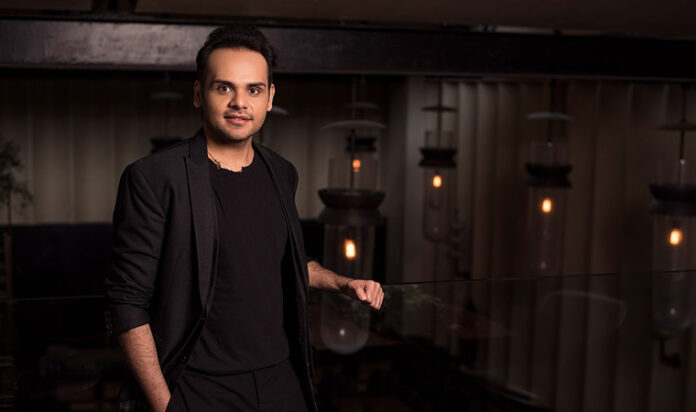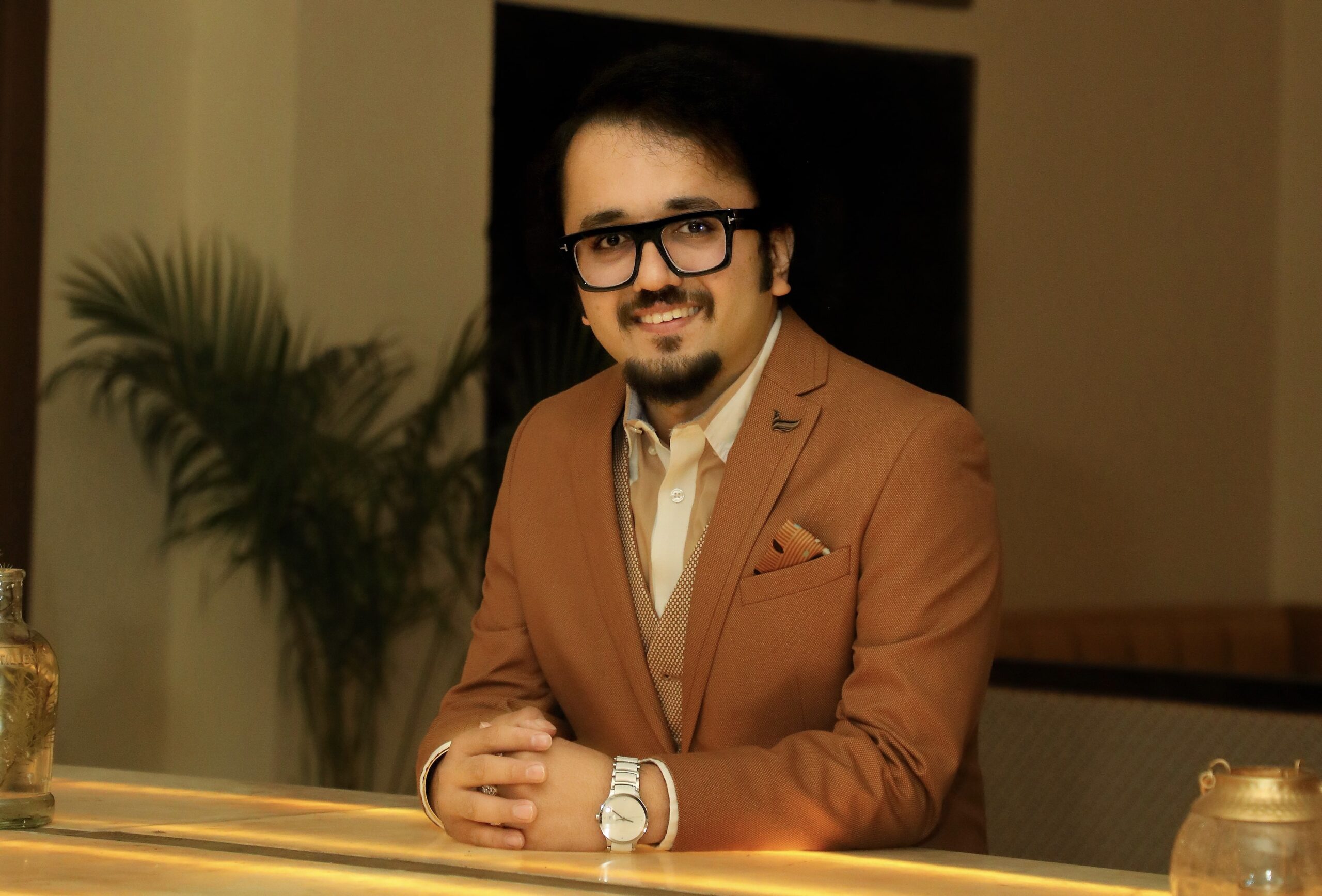From the smorgasbord of design that is his life, Ashiesh Shah, perhaps India’s best known architect, finds luxury in what he loves best—his ability to create new things
The first thing this impish-looking 38-year-old does at work every day is to write the word ‘stillness’ on his mood board in his office in Tardeo, Mumbai. For Ashiesh Shah, finding that stillness is all important. “Our lives are so hectic, it’s good to seek stillness. There may be situations that move me up and down, but the overarching emotion should be stillness. That’s the real form of meditation. Meditation is not a 10-minute thing you do every morning, it’s a philosophy. Design is introspective. When you put that pen to paper, you’re actually introspecting on every line you’re drawing because you’re creating something. That is meditation, too. If you can find meditation through your work then nothing like that. That is where you spend your maximum number of waking hours. If you can meditate through work, that’s nirvana.”
Design is introspective. When you put that pen to paper, you’re actually introspecting on every line you’re drawing because you’re creating something. That is meditation, too. If you can find meditation through your work, that’s nirvana.
Ashiesh taps deep into the persona when he creates a habitat for someone. Actor Hrithik Roshan’s huge home with an ocean view in Juhu now exudes a cosy and intimate energy with nautical elements. Ashiesh says, “His study is one of my favourite spots in the house. I wanted it to mirror his personality – serious substance, yet a lot of fun.” Or there’s actor Jacqueline Fernandez’s home in Bandra, which reflects her zestful, well- travelled personality to a tee. “She’s into fitness and loves music, which explains her private pole-dance studio in the house, her vintage music player and the piano in her living room, the knick-knacks and books she’s collected from over the years. I went with shades of white with pastel blue and pink accents, brought in the beautiful view of the sea from the large floor-to-ceiling windows, added little plants everywhere as well as some vintage elements. Her home now marries her elegance and femininity and has a calming energy overall.”
 Ashiesh Shah
Ashiesh ShahThe quest for a thoughtful narrative is even reflected in his clothes. “I’m not someone who buys the obvious labels too much. I prefer brands that actually have a philosophy.” Among Indian labels, he favours Raw Mango, whose store in South Mumbai he has designed. “They do mainly saris, but they make clothes for me sometimes. And there’s this brand called Itoh that they stock. It’s a very nice, loose linen, Japanese-Indian kind of aesthetic, which I love. I also like Shift a lot. (Designer and owner of the brand) Nimish (Shah) is a close friend and we understand each other’s aesthetic well.”
Internationally, his basics are Acne, APC, MR Editions, AMI… these are the brands he usually wears. He admits he likes the freedom to choose. It could be a khadi kurta to work one day and a bomber jacket the next. On a dull day, he may dress it up just to feel perked up. He sounds like a fashionista. He laughs this away. “People close to me say I’m fashion conscious, but I’m actually quite effortless (about it). I love shopping because I feel that puts me on the other side of the table where I can point to something and say, ‘I want that!’ Usually I’m the one making things, so this is my opportunity to consume. I like shopping, but my tastes are so simple that I go to the most expensive shop and buy just a black T-shirt! The most expensive black T-shirt. It’s a basic, which (is what) I like to spend on. I like to spend on things (that I use) every day because I believe that luxury is for every day, not for a weekend or an occasion.”
Luxury means different things to different people. Ashiesh puts his mind to it and doesn’t answer immediately, then he says thoughtfully, “Luxury is defined by the self. It’s what you believe in. It could be the Kolhapuri chappal I buy from Colaba Causeway for Rs 100 or a bag worth thousands of rupees. What is luxurious to me might be indulgent for someone and frugal for someone else.” Most of all, luxury for him is a product that has a provenance, a story and a richness of thought behind it. His own home with its vast collection of art and carefully collected pieces with a history is a case in point.
I go to the most expensive shop and buy just a black T-shirt! I like to spend on things (that I use) every day because I believe that luxury is for every day, not for a weekend or an occasion.
“I like anything with a philosophy. And that’s the idea behind Atelier (a section that showcased furniture and accessories at the recent art and design fair D/code 2018 curated by him) as well… let’s follow a philosophy,” he says, as he talks about his newest project. Atelier hopes to amalgamate experimentation, craftsmanship and technique into a creative ecosystem for collaboration and development.
For Ashiesh, transitioning from interior to product design was a natural progression, propelled by years of designing custom furniture pieces for his clientele. Expect prêt and premium edition collections, reflecting his signature style of clean lines and raw textures. This adjunct to his current work will celebrate the master craftsmen and tribal artists of India by bringing their work into the limelight. Combining his knowledge of contemporary design and their expert skills in creating a product that will be so exquisite, it will be truly unique.
 Ashiesh Shah
Ashiesh ShahAshiesh is passionate about this and is keen to elaborate what he has in mind. “India is a major voice when it comes to manufacturing for design, be it fashion or for home. We are culturally very rich with what we do with our own hands. The skills are so unique that the West would have to pay through their nose to have access to that. The world is moving towards handmade. We’ve had enough of machine-manufactured, overtly consumed fast design. For example, if you’ve gone to Milan and bought a chair, your neighbour could have got the same design from China at one-tenth the cost. I feel that there should be a voice from the country that says you cannot copy this. If you try to copy it, you will fall flat because you won’t have the material or the master skills. That’s where we want to be, almost copy-free. We already have the knowledge of what’s trending, the design aesthetic of the world at this point. With Atelier, we can bring Indianness to that and make it our own.”
His dream is to create a design gallery where the right voices will be heard and consumed in a way they should be. It’s a big risk, but one that he is ready to take as he believes its time has come. “Hopefully, this will give us the opportunity to do something bigger than just going to Europe and buying a piece of furniture and putting it in the living room. I also feel we should have pieces that are conversation starters. Where you can say, ‘By the way, this is this, designed by this person and manufactured by so and so.’ Today, if you’re buying a chair, you may know who designed it, but you rarely know who made it and how. That is equally important – bringing the hand back into design. Right now, the machine is into design, and if it isn’t stopped soon, artificial intelligence will be into design. But I want to pull it back to slow design, conscious design, which also ensures that the money goes into the right pocket.”
Luxury is defined by the self. It’s what you believe in. What is luxurious to me might be indulgent for someone and frugal for someone else.
Atelier comes after years of creativity, working on carefully chosen projects and pushing the boundaries of what an architect and interior designers does. After quitting dentistry to follow his heart he did a course at the Rachana Sansad Academy of Architecture in Mumbai and then one on Interior Architecture, Lighting Design and Product at the Parsons School of Design in New York. He worked with a firm before he started off on his own a decade ago.
Today, his company has a designation-free structure where everyone gets a say which allows for a very positive vibe. His ideas have birthed trends in the country, such as industrial chic that became popular after he styled the store Le Mill or garden-theme restaurants after Nido (now defunct). His more recent work with Masque and Chef Hemant Oberoi’s fine-dining restaurant sparkles. He collaborated with Urban Ladder for a selection of pieces that evoke the Japanese philosophy of Wabi Sabi (appreciating the beauty in imperfection).
 Ashiesh Shah
Ashiesh ShahAnd yet he breathes India and uses local materials like cane, familiar shapes like the lingam and functionality that befits the needs of the average Indian home owner. Ashiesh has reached our homes through his own TV show called Design HQ on Fox Life India last year, which took a peek into the homes of some celebrities he designed. Awards have come from every quarter and his has been considered a name of worth on many laudable lists.
Not bad for the shy boy from the family of doctors who didn’t have many friends as a child. “If you were a boy who didn’t play cricket or football you weren’t popular back then, which is very different from today’s times where parents are very supportive of a son who only wants to go to craft class or play Lego! In those days, Lego was not a real thing. It was a luxury. It was what you did with your father on a weekend, not every day.” That childhood yearning to build rather than bat has borne fruit now.
He’s cheerful about it. “What it did to me is that every morning that I can spend time on design, I still find a luxury. I feel like it’s a Sunday! If I had done it every day as a child, I may not have felt the same about it now. But that’s the way you should get up and feel every day about your work, right?”



